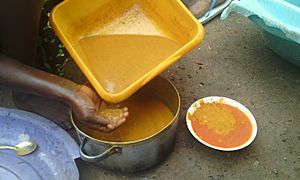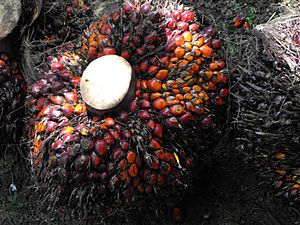Palm oil facts for kids
Palm oil is a type of vegetable oil that people can eat. It comes from the fleshy, reddish part of the fruit of oil palm trees. The main type of oil palm is the African oil palm.
Palm oil is naturally reddish because it has a lot of something called beta-carotene. This is the same stuff that makes carrots orange! It's important not to mix up palm oil with palm kernel oil. Palm kernel oil comes from the hard seed (called the kernel) inside the same fruit. Also, it's different from coconut oil, which comes from coconuts.
There are a few key differences:
- Palm oil is red, but palm kernel oil is not. This is because palm kernel oil doesn't have beta-carotene.
- Palm oil has about 49% saturated fat. Palm kernel oil and coconut oil have much more, around 81% and 86% saturated fats.
- When raw red palm oil is cleaned and processed (called RBD palm oil), it loses its red color and the beta-carotene.
Sometimes, food companies use special parts of palm oil that have been changed. These are often called "modified palm oil." They can have very high levels of saturated fat, sometimes up to 90%.
Oil palm trees grow bunches of fruit. Each fruit has a soft, fleshy part (the mesocarp) and a hard shell covering a kernel. The oil from the fleshy part is palm oil. The oil from the kernel is palm kernel oil. You can get about 17% to 27% palm oil from a bunch of fruit, and 4% to 10% palm kernel oil.
Along with coconut oil, palm oil is one of the few vegetable fats that is mostly solid at room temperature. It's a very common ingredient for cooking in places like Africa, Southeast Asia, and parts of Brazil. Food companies around the world use it a lot because it's cheaper and stays fresh for a long time, especially when used for frying. In 2015, people around the world ate about 17 pounds (7.7 kg) of palm oil per person!
Palm Oil and the Environment
The widespread use of palm oil has caused some worries for environmental groups. Because oil palm trees produce so much oil, more and more forests are being cut down to make space for large palm oil farms. This is happening in places like Indonesia.
Cutting down these forests means that animals lose their homes. This is a big problem for orangutans, especially the Sumatran orangutan, which is now considered critically endangered. This means they are at a very high risk of disappearing forever.
To help with these concerns, a group called the Roundtable on Sustainable Palm Oil (RSPO) was created in 2004. This group works with the palm oil industry to find ways to produce palm oil more responsibly. Also, in 1992, the Government of Malaysia promised to keep at least half of its land covered by forest cover. This was to help protect forests from being cleared for palm oil farms.
Images for kids
-
Oil palms (Elaeis guineensis)
-
A satellite image showing deforestation in Malaysian Borneo to allow the plantation of oil palm
-
In Borneo, the forest (F), is being replaced by oil palm plantations (G). These changes are irreversible for all practical purposes (H).
-
Left, reddish palm oil made from the pulp of oil palm fruit. Right, clear palm kernel oil made from the kernels
See also
 In Spanish: Aceite de palma para niños
In Spanish: Aceite de palma para niños













